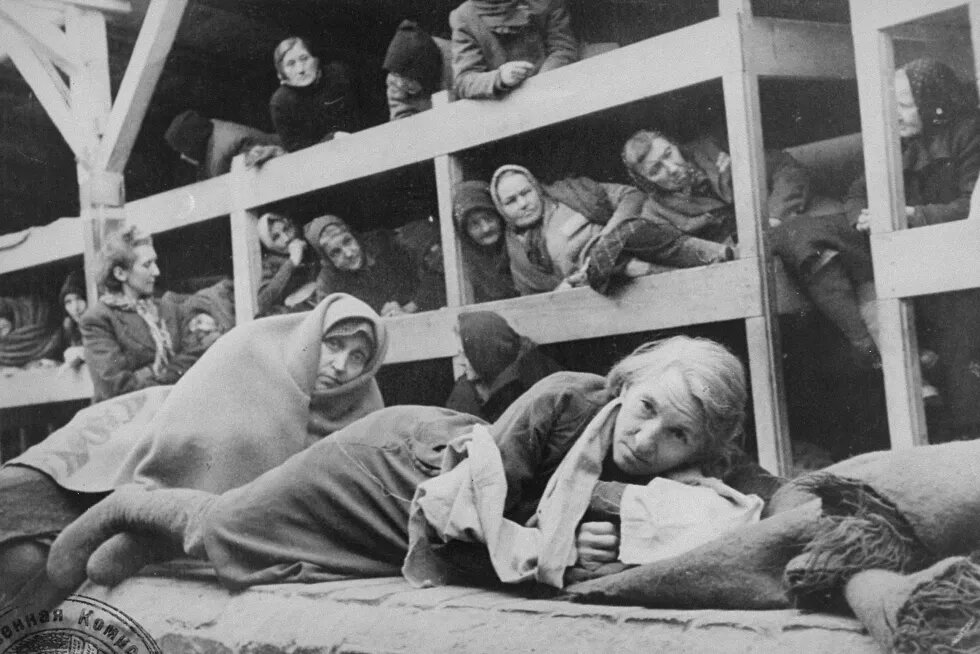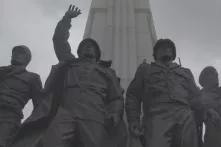The experiences of women in the Second World War with sexualised violence show that some suffering was gender-specific. According to the sources, sexualised violence against Jewish women and girls was not a by-product of the war, but the war itself, organised and controlled by those who denied Jews their right to exist.

Perpetrators: Who and Why?
Forms of Sexual Violence
• Brutalization of Women’s Bodies and Genocidal Sexual Violence
• (Gang) Rape
• Forced Prostitution
Effects of Sexual Violence
As historian Raul Hilberg argued, “The road to annihilation was marked by events that specifically affected men as men and women as women.”[1] Both sexes were subjected to similar forms of persecution and violence — abuse, forced labour, starvation, deportation, humiliation, and death, but only women had to cope with pregnancy, abortions, and invasive gynaecological examinations.[2] Even though some Jewish men experienced various forms of sexual violence, the majority of rape victims and survivors are women.[3]
Despite the growing interest in women’s experiences in the Holocaust, the issue of sexual violence remains one of the under-researched topics. The war-time Ukraine could serve as a focus and lens through which questions of sexual victimization and sexual agency of Jewish women during the Shoah could be studied.
Sexual assault occurred in different locations, including Jewish homes, streets, and prisons, killing sites, and hiding places. In hundreds of ghettos and camps (e.g., concentration camps, forced labour camps) in occupied Ukraine during the Second World War, Jewish women were particularly vulnerable to various patterns of sexual humiliation and abuse.
Perpetrators: Who and Why?
Sexual violence during the Holocaust in Ukraine, like everywhere in Nazi-dominated Europe, was gendered first of all in terms of sexes of the perpetrators and the victims. The vast majority of victims/survivors were women, and perpetrators were mostly men — Germans and their allies, e.g., Hungarian, Romanian, Italian and local collaborators, and fellow Jewish inmates.
There is no convincing evidence that they were under orders to rape women, as it happened during genocides in Rwanda or former Yugoslavia. What drove those men to become rapists? Today, there are numerous ideas attempting to explain the motivations behind sexual crimes during wartime and genocide.
One of the more productive theories is the multifactorial model wherein multiple factors, when combined, provoked sexually violent behaviour in men.[4] Political and ideological factors significantly contributed to the proliferation of sexual violence during the Holocaust. Sexual humiliation of the Jewish body was an inevitable consequence of the dehumanizing Nazi racial theories.
The notion that sex with a Jewish woman (even coercive) would constitute “racial defilement” (Rassenschande) was not an effective mechanism for preventing rape by Germans because some of them did not consider this rape to be a crime. For many perpetrators, the myth of Judeo-Bolshevism justified violence against the Jewish, who were accused of supporting the Soviet rule. Thus, rape could be but one way to punish and humiliate the Jews.
In this framework, rapists placed the blame for the rape on women themselves, believing they “deserved” it for their political choice. Consequently, women were raped not just because they were women, but specifically because they were Jewish women. The war factor meant that quite a few sexual offenders were perpetrators or witnesses of numerous violent acts, including killing, which made them accustomed to violence in general and enabled the extension of the range of violence as far as to include rape.
Furthermore, being far away from home, many men did not feel the social control that could be a deterrent before the war. In addition, the war of Germany and its allies on the Eastern Front was crueller in its attitude to civilians. In other words, soldiers’ sexual crimes were much more likely to be prosecuted in France than those committed in Ukraine.
The military culture with its cult of physical strength, hegemonic masculinity and dominance over women highly contributed to sex crimes, especially when it came to gang rape. As feminist scholars pointed out, in some military groups gang rapes served as a tool for building military brotherhood. The presence of disinhibitors (alcohol, drugs, pornography) was undoubtedly a catalyst of sexual crimes. The memories of Holocaust survivors include plenty of mentions of “drunk” Germans, Romanians, police officers who “sought after young women” at night.[5]
Misogyny is one of the factors inciting gender-based violence both in peacetime and at war. Misogyny was an immanent part of the Nazi ideology, well put in practice in the Third Reich. The circumstances at war, namely, men’s fear and frustration provoked aggression towards vulnerable groups, including women. Personal motives are connected with the offenders’ education, mindset and experience.
Some men believed in their “right” to force women to satisfy their sexual needs. But sexual drive could not be considered a dominant motive for rape because sexual violence is about power, not about sex. Rape is not about sex in its violent manifestation. Rape is violence in its sexual manifestation.
Forms of Sexual Violence
Brutalization of Women’s Bodies and Genocidal Sexual Violence
As historian Regina Mühlhäuser has pointed out, hair shaving, forced undressing and genital inspection during the Shoah produced feelings and meanings in women that differed from those of men due to socialized gendered roles and expectations. Those acts threatened men’s security rather than being associated with sexuality or sexual humiliation.[6]
During those “routine procedures” in camps and ghettos, women suffered not only from men’s unpleasant scrutiny, but also from the fact that men were touching their breasts and genitalia. Some bodily searches for valuables were overt acts of sexual violence. There were also cases of sexualized violence perpetrated with the aim of punishing women for certain wrongdoings and intimidating others.
Edmond Baumvald, Holocaust survivor of the Janowska camp in Lviv, recalled that a member of camp leadership forced Jewish newcomers to strip in order to take their possessions. One of the young women refused to do so. For disobedience, he forced her to lift her skirt from behind and then shot her in the genitals. He called up a Jewish man and ordered him to cart her around the square until she died.[7]
In some camps and ghettos, women went through forced abortions, sterilizations and medical experiments. Beila Habis, Holocaust survivor from the Bershad camp in Vinnytsia oblast, remembered that women in the camp “had formaldehyde solution injected in utero,” which caused strong pain and bleeding.[8] Such violence constituted an attack against women’s reproductive body biologically designed to reproduce the Jewish nation; it can thus be considered genocidal sexual violence.
(Gang) Rape
In many cases, rape went hand in hand with looting of Jewish properties. In such cases, rape was a method of terror and torture to intimidate women and find out the location of valuables, or the tool of punishment if the offenders failed to get what they came for. Such rapes often took place in Jewish homes or next to them with the woman’s family present. There were also rapes taking place independently of looting.
Germans or their collaborators raped women in barracks or in their homes or workplaces. To hide the crime, they would often kill the women afterwards. According to the recollections of Holocaust survivors, Volksdeutsche Florian Koch, who served as a guard in the Bohdanivka camp in Odesa oblast, took teenage girls of ages 17–18 from pigsties where they were staying with other Jews, took them to a barn, robbed, raped and shot them.[9]
Gang rape was not a rare phenomenon during the Holocaust. Groups of perpetrators would barge into barracks and rape young women right in front of everyone present. Those who resisted could be beaten or killed. Some girls and young women were chosen specifically for sexual abuse. They were selected among permanent residents of ghettos and camps.
Selections would take place in the barracks, in training yards, during recruitment, after the women came back from work, or before deportations. They would usually take several young women at once. A survivor of Stepan ghetto remembers: “At night, policemen would bring Germans, and they would grab young women and rape them. They really brutalized them… They took [the women] away, and then brought them back and left them half dead.”[10]
Golda Wasserman, survivor of the Tulchyn ghetto, describes: “A Romanian gendarme who was the Commandant of Tulchyn selected healthy young girls from the ghetto and took them away, under the official pretence of working in the kitchen and bakery of those [Italian and Hungarian] divisions located [15 kilometres from the ghetto]. The girls returned having been raped and with venereal diseases. Many committed suicide back in the barracks, while some of them were killed when resisting or attempting to flee.
Then the Commandant selected new girls for the ‘work.’ Selection was carried out every fifteen to twenty days.”[11] Some rape victims were killed with special cruelty. Irvin Szames, survivor of Trohenbrod ghetto near Lutsk testified that the bodies of raped women had been massacred.[12] The women were also immediately killed if, after a period of sexual exploitation, they contracted an STD or got pregnant.[13] Some of those who did come back after rape died from the injuries or committed suicide.
Forced Prostitution
Leadership of the ghetto and camps, as well as guards, often took advantage of their position of power and coerced women and girls into sex in exchange for food, medicines, and protection from deportation, or under the threat of killing the women themselves or their loved ones. Klara, Jewish survivor of the Kamianets-Podilskyi ghetto, recalls: “Chaikovskyi [a policeman] usually let women out of the ghetto only if they agreed to a sexual relationship with him.
That way, hungry women agreed to have sex with Chaikovskyi only to be allowed to go to the market and get some food. There were many such cases, and everyone in the ghetto knew about it… [He] raped ghetto inhabitants Tania Brott, a woman named Khanka, young girls Basia and Donia Amster and many others. They would later come to me and my mother, cry and tell us about it.[14]
Some men from camp leadership would hire young girls as house servants, forcing them to provide sexual services. At the same time, some women perceived their body as an important resource to save themselves and their loved ones. Such women could initiate sex with powerful men on their own, which Myrna Goldberg called “sex for survival.”[15]
Galina Klotsman, Jewish survivor of a forced labour camp for the Jewish in Antonivka of Kyiv oblast, remembers: “There was one woman from Piatigorsk with us. She went for it herself, and she was allowed to leave the camp, and she ran away.[16] Jewish survivor Semyon Dodik recalls that he knew a pretty young Jewish girl Olia from Nova Ushytsia, who saved herself from execution by firing squad. In his recollections, he emphasized that she had managed it with “the help of policemen to whom she provided certain services, which she didn’t hide.”[17]
Despite the later, post-war stigma emerging around women who had to engage in prostitution, some of them successfully helped other Jews in ghettos and camps thanks to their intimate relationships. For instance, Anna Ivankovitser recalls that a Jewish girl in the ghetto in Shargorod fraternized with one Romanian man, and she helped other Jews to bribe him for some goods.[18]
Recognizing the somewhat limited agency of Jewish women in situations of “negotiated sex,” we have to keep in mind the extreme imbalance of power between those women and men who used women’s exceptional vulnerability. Taking this into consideration, this form of contact can be considered a form of sexual violence.
Effects of Sexual Violence
Sexual violence was a means of terror and social control not just over women, but also over the entire Jewish community. Stories and rumours about rape would instantly spread throughout camps and ghettos, inciting fear. Young girls witnessed women being raped or killed. Ava Dorfman recalls her experience from the Janowska camp: “One time in the roll-call order there were young people, and the older people were sitting, and the Ukrainian took — her name was Bosha — took her out, and we thought maybe he was going to save her, but when she came back, she said he raped me, and then he came and shot her.
I had all her blood, you could [imagine] everything from her brain. He shot her right here in the head. How can you have a very normal life when you think of that.”[19] Parents did everything possible to save their daughters from rape. They would hide them, dress them in rags, hide or cut their hair, smear soot on their faces to make them unattractive, spread rumours about girls suffering from typhoid fever and other diseases.[20]
Despite all the effort, they often had to witness brutal sexual violence against their own children, which they could not prevent or stop. This produced a profound feeling of guilt and helplessness. And those feelings were gendered as well: Jewish men experienced sexual assault as emasculating acts related to their inability to protect “their women.” The presence of loved ones during rape was an additional humiliating factor for the survivors of rape.
Overall, the psychological consequences of sexual violence for the victims/survivors themselves cannot be overstated. That was a loss of personal dignity, security, beliefs and a sense of identity. Some women committed suicide after being raped. Others developed mental illnesses. One of the Jewish survivors of the Bohdanivka camp remembers: “My acquaintance Rosenblatt and his family were with me. One night, Slyvenko (a policeman) took his wife Rosa. In the morning, she came back in pain, with torn clothes, and said that the policemen had raped her. Shortly, she lost her mind and died.”[21]
Many women suffered severe injuries as a result of sexual violence. They had uterine and vaginal bleeding. Klara of the Yarun ghetto in Zhytomyr oblast recalled that women who resisted rape would have their stomachs stabbed with gun sticks.[22] Some women were killed afterwards.
Another outcome was unwanted pregnancy. There were women who carried them to term, while others tried to get an abortion, both options generating additional risks. Rape, medical experiments and sterilization had dramatic consequences in the long term, making many women unable to get pregnant in the future.
Women’s experiences of WWII prove that some suffering is indeed gendered, none more so than sexual violence. Nazi camps and ghettos in Ukraine were just some of the places in the topography of sexual terror against Jewish women and girls. But it was there, in the spaces of forced confinement and lack of freedom, where sexual violence was especially concentrated, widespread and brutal.
The available sources lead us to the conclusion that sexual violence against Jewish women and girls was not just a by-product of war; it was war itself, organized and controlled by those who denied the Jews their very right to existence. Sexual violence was both a consequence of the dehumanization of Jews and a means of their dehumanization, designed to facilitate the process of killing and to absolve the Nazi murderers and their collaborators from guilt and regret.
A detailed study of every case of sexual violence during the Holocaust will help us to cast light on the gendered suffering experienced by numerous women, as well as to show how sexual violence becomes not only a crime against human dignity but also a tool of genocide and war in itself.
[1] Raul Hilberg, Perpetrators, Victims, Bystanders: The Jewish Catastrophe (1933–1945) (London: Harper Press, 1993), 126.
[2] Nicole Ephgrave, “On women’s bodies: Experiences of Dehumanization during the Holocaust,” Journal of Women's History, 28(2) (2016):14.
[3] Despite the fact that various groups of women were targeted for sexual violence during the Holocaust in Ukraine, e.g. Sinti and Roma women, female members and supporters of Ukrainian, Polish and Soviet partisan groups, and Jehovah’s Witnesses, this article focuses exclusively on Jewish women and girls.
[4] See, e.g., Nicola Henry, Tony Ward, Matt Hirshberg, “A multifactorial model of wartime rape,” Aggression and Violent Behavior, 9 (2004): 535-62.
[5] See, e.g., Testimonies 26606 and 52311, USC Shoah Foundation Institute Visual History Archive (USC Shoah Foundation VHA).
[6] Regina Mühlhäuser, “Sexual violence and the Holocaust” in Gender: War, ed. by Andrea Peto (Farmington Hills (MI): Macmillan Reference, 2017), 102.
[7] United States Holocaust Memorial Museum (USHMM), RG-31.018M, reel 35, spr. 29230, ark. 48.
[8] USHMM, RG-31.027, box 11, testimony 39.
[9] USHMM, RG-31.018M, reel 92, t. 1, spr. 10890, ark. 113-114; USHMM, RG-31.018M, reel 19, spr. 13189, t. 25, ark. 267.
[10] Testimony 45238, USC Shoah Foundation VHA.
[11] Cited in Anatoly Podolsky, “The Tragic Fate of Ukrainian Jewish Women under Nazi Occupation, 1941–1944,” in Sexual Violence against Jewish Women during the Holocaust ed. Sonja M. Hedgepeth and Rochelle G. Saidel (Waltham, MA: Brandeis University Press, 2010), 103.
[12] Testimony 10829, USC Shoah Foundation VHA.
[13] Patrick Desbois, The Holocaust by Bullets: The Mass Shooting of Jews in Ukraine 1941–1944 (Paris: Memorial de la Shoah, 2007), 126.
[14] USHMM, RG-31.018M, reel 52, spr. t.2, ark. 107, 120.
[15] Myrna Goldenberg, “Rape during the Holocaust,” in The Legacy of the Holocaust: Women and the Holocaust, ed. Zygmunt Mazur, Jay T. Lees, Arnold Krammer, and Władysław Witalisz (Kraków: Jagiellonian University Press, 2007), 109.
[16] Testimony 33997, USC Shoah Foundation VHA.
[17] Semyon Dodik, Sudba i zhizn malchika iz rasstrelyannogo getto [Судьба и жизнь мальчика из расстрелянного гетто], https://www.proza.ru/2004/01/10-149. Last view 8 October 2019.
[18] USHMM, RG-31.027, box 8, testimony 11.
[19] USHMM, RG-50.030.0317 (The Jeff and Toby Herr Oral History Archive)ю
[20] Testimony 52632, USC Shoah Foundation VHA.
[21] USHMM, RG-31.018M, reel 92, t. 3, spr. 10890, ark. 257.
[22] Testimony 15272, USC Shoah Foundation VHA.




